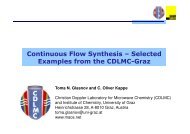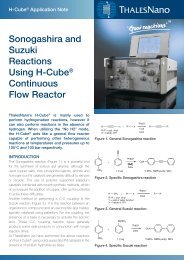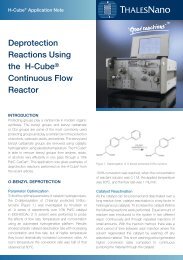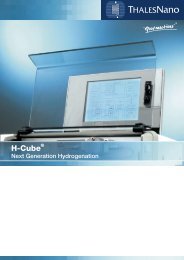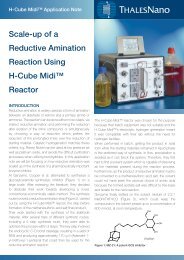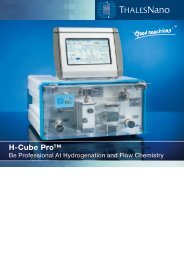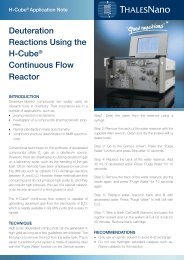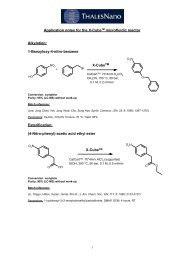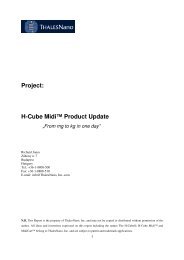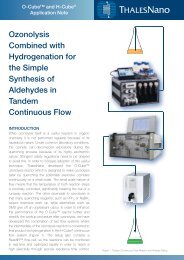O-Cubeâ„¢ Application Note - ThalesNano
O-Cubeâ„¢ Application Note - ThalesNano
O-Cubeâ„¢ Application Note - ThalesNano
You also want an ePaper? Increase the reach of your titles
YUMPU automatically turns print PDFs into web optimized ePapers that Google loves.
O-Cube <strong>Application</strong> <strong>Note</strong><br />
Safe and Fast<br />
Ozonolysis Using the<br />
O-Cube<br />
Continuous Flow<br />
Reactor<br />
INTRODUCTION<br />
Ozonolysis is a fundamentally important oxidation<br />
reaction, which has never been fully adopted due to the<br />
safety concerns with performing the process. Its main<br />
importance stems from the fact that you can selectively<br />
oxidize double or triple bonds to form hydroxyl groups,<br />
aldehydes, or carboxylic acids in the presence of other<br />
oxidizable groups (Figure 1). Other conventional oxidative<br />
methods are not so selective, are slower to react, require<br />
addition of water or need purification to eliminate side<br />
products leading to lower yields or need the use of<br />
metal catalysts [1]. Compared to other methodologies,<br />
ozonolysis is considered as a greener way of oxidation<br />
[2]. Ozonolysis has been used frequently in major drug<br />
syntheses such as (+)-Artemisinin, Indolizidine 251F, and<br />
D,L-Camptothecin and with finechemical syntheses such<br />
as L-Isoxazolylalanine and Prostaglandin endoperoxides.<br />
FLOW OZONOLYSIS<br />
In order to overcome the difficulties associated with<br />
ozonolysis, such as dangerous workup of the potentially<br />
explosive ozonide, use of low temperature, and<br />
complicated setting up of ozonizer equipment, <strong>ThalesNano</strong><br />
has developed the O-Cube ozonolysis flow reactor. The<br />
O-Cube system is a compact instrument dedicated for<br />
performing ozonolysis and low temperature reactions.<br />
The O-Cube reactor is safer and more efficient than<br />
standard batch equipment due to the small reactor<br />
volume and precise temperature control. The compact<br />
manner of the O-Cube reactor allows chemists to carry<br />
out the formation and reductive or oxidative cleavage of<br />
the secondary ozonide in one instrument.<br />
GENERAL PROCEDURE<br />
The O-Cube reactor generates ozone via a continuous<br />
flow of oxygen gas from a cylinder and an internal<br />
ozonizer. The ozone is mixed with a continuous stream<br />
of precooled starting material, controlled using two<br />
syringe pumps. The gas/liquid mixture is then pumped<br />
into a cooled reaction zone, which may be cooled down<br />
to a temperature of -25 °C. The volume of the reactor<br />
tubing is 10 cm 3 . After passing through the cooler, the<br />
formed ozonide mixes with the quench reagent solution,<br />
supplied by two separate syringe pumps. The quenching<br />
is performed in a secondary cooler before eluting into a<br />
collection vial. All the reaction conditions, such as flow<br />
rates of starting material and quenching agent, reaction<br />
temperature and ozone amount (%), were previously set<br />
on the touch screen panel of the instrument.<br />
Figure 1: Mechanism of ozonolysis reaction
RESULTS OF ALKENE OZONOLYSIS<br />
Prof. Kappe’s group at University of Graz converted<br />
different alkenes to the corresponding aldehydes/ketones<br />
[3] (Scheme 1.) by reacting 0.05 M of starting materials<br />
with ozone (concentration of 5%) in the O-Cube reactor<br />
resulting in isolated yields of 72-90%, which were found to<br />
be comparable to the published batch ozonolysis results.<br />
As the two steps of the reaction process were carried<br />
out in the same reactor unit, the only process needed<br />
to obtain the 100 – 215 mg products within the 40 mins<br />
reaction time was the evaporation of solvent. Peroxide<br />
strips were used to make sure there was no ozonide and<br />
ozone remaining in the reaction mixture.<br />
RESULTS OF AMINE GROUP OZONOLYSIS<br />
Adopting the same reaction conditions from the alkene<br />
ozonolysis, an alkyl amine was oxidised to the nitro form.<br />
After ozonolysis the ozonide was quenched to result in the<br />
desired 1-nitrooctane with a 73% yield (117 mg) within 40<br />
mins.<br />
RESULTS OF THIOANISOLE OZONOLYSIS<br />
Oxidation reactions of thioethers often lead to the sulfone<br />
due to the fast oxidation of sulfoxide intermediate.<br />
Under flow conditions, by altering the reactions<br />
conditions (ozone concentration and the nature of<br />
quenching agent), both the sulfoxide and sulfone could<br />
be selectively synthesized in high yield, 84 and 87%<br />
respectively, after a simple work-up procedure. With<br />
the sulfone synthesis, the only method necessary to<br />
obtain the product was the evaporation of solvent after<br />
making sure there was no ozonide and ozone remaining in<br />
the reaction solution. Further data of the two representative<br />
reactions can be found in Scheme 3.<br />
<strong>ThalesNano</strong> Nanotechnology Inc.<br />
Zahony u. 7.<br />
H-1031 Budapest<br />
Hungary<br />
Tel.: +36 1 880 8500<br />
Fax: +36 1 880 8501<br />
E-mail: sales@thalesnano.com<br />
US Office <strong>ThalesNano</strong><br />
50 S. Penn St. Suite B-2<br />
Hatboro<br />
PA. 19040<br />
USA<br />
Phone: +1 732 274 3388<br />
E-mail: USAsales@thalesnano.com<br />
O-Cube <strong>Application</strong> <strong>Note</strong><br />
1.) MeOH, 25 °C, 1 mL/min, 0.05 M, 3% ozone 90%<br />
2.) NaBH 4 /MeOH, 25 °C, 0.7 mL/min<br />
1.) Me 2 CO, 25 °C, 1 mL/min, 0.05 M, 3% ozone 84%<br />
2.) 5% H 2 O/Me 2 CO, 25 °C, 0.7 mL/min<br />
Scheme 1: Ozonolysis of alkene groups followed by reductive quenching<br />
1.) EtOAc, 25 °C, 1 mL/min, 0.05 M, 10% ozone (3 equ.) 73%<br />
2.) 1.5 M H 2 O 2 /CHCl 3 , 25 °C, 0.5 mL/min<br />
Scheme 2: Ozonolysis of amine groups followed by oxidative quenching<br />
1.) Ozonolysis: MeOH, 25 °C, 1 mL/min, ozone: 1 equ.<br />
Reductive quenching: 0.1 M NaBH 4 /MeOH, 25 °C, 0.7 mL/min<br />
2.) Ozonolysis: MeOH, 25 °C, 0.5 mL/min, ozone: 4 equ.<br />
Oxidative quenching: 5 M H 2 O 2 /MeOH, 10 °C, 0.5 mL/min<br />
Scheme 3: Reaction conditions and results of thioanisole ozonolysis<br />
REFERENCES<br />
[1] (a) Bailey, P. S.; Chem. Rev., 1958, 58, 925-1010; (b) Baley, P. S.; Ozonization in Organic Chemistry, Olefinic<br />
Compounds; 1978; 1; (c) Bailey, P. S.; Ozonation in Organic Chemistry, Academic: San Diego; Chem. Abstr.; 1982, 2;<br />
312-319; (d) Razumovskij, S. D.; Zaikov, G. E.; Ozone and Its reaction with Organic Compounds; Elsevier: Amsterdam; 1984<br />
[2] Pluim, H.; Dyer-Smith, P.; Exner, M.; Chimica Oggi/Chemistry Today; 2011; 29(1); 59-62<br />
[3] Irfan, M.; Glasnov, N. T.; Kappe, O. C.; Organic Letters; 2011; 13(5); 984-987<br />
UK Office<br />
Carl Jones<br />
Head of European Sales<br />
Tel.: +44 (0) 7868 843 819<br />
E-mail: UKsales@thalesnano.com



